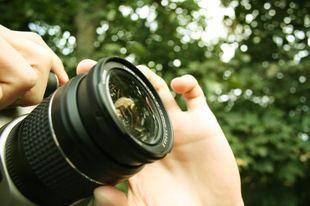
Understanding the differences in camera lenses will help you take better pictures.
About Camera Lenses
If you own a SLR camera, you have the luxury of interchanging lenses. A single camera body, regardless of whether it's film or digital, is able to accommodate a variety of different lenses, from an 8mm fisheye lens to a 500mm telephoto lens.
Different lenses yield different results. Camera lenses are not created equally--in price, size or function. Consequently, it is critical that you learn the differences in camera lenses before draining your wallet on a lens that doesn't fit your shooting style.
Some factors to consider before settling on a single camera lens include:
- Length
- Weight
- Durability
- Ease of use
- Filter accommodation
- Size of markings for aperture settings, focus distance, etc.
- Rotation elements (Do you prefer a push or pull zoom lens?)
Tips to Understand the Differences in Camera Lenses
Understanding the differences in camera lenses allows you more control over your shots. Choosing the right lens for a particular shoot, be it a sporting event, a wedding or a fashion show, can be a challenge if you are not familiar with lens concepts and options.The following information on camera lenses will help you choose the best camera lenses for your photography style:
Wide-Angle Lens
When it comes to shopping for a wide-angle lens, you need to know about focal length. The focal length of a lens determines how much your subject will be magnified. Wide-angle lenses have small focal lengths, while telephoto lenses have larger focal lengths. If you are shooting with a wide-angle lens, your image will have a small amount of magnification and the widest angle of view. This makes far-away objects appear relatively small. Focal length is identified by a measurement such as 50mm or 180mm. Some common wide-angle lenses are 20mm, 24mm, 28mm, and 35mm. These lenses are able to provide a relatively large depth-of-field and are best employed when shooting landscapes, as they capture large portions of scenery.
Telephoto Lens
Telephoto lenses range from 80mm to 800mm and are most often used by photographers whose subjects are located a great distance away. The role of the telephoto lens is to magnify the subject without the photographer having to move closer. Telephoto lenses are best used when shooting sporting events or animals in their natural habitats. The downside to using a telephoto lens is that it is more susceptible to camera shake. Even the smallest hand movements can negatively affect a shot. To avoid taking blurry pictures with a telephoto lens, consider attaching your camera to a tripod to minimize shake.
Zoom Lens
A zoom lens allows photographers to vary the focal length within a pre-defined range, such as 35-70mm. This is a plus for photographers who cannot afford to purchase a litany of individual lenses covering the same range. In addition to being able to achieve a variety of focal lengths, zoom lenses are incredibly popular because they are easy to use. Some zoom lenses are automatic, while others can be easily manipulated with a simple push or pull. Another advantage of owning a zoom lens is that it is multi-functional. It helps enhance a variety of photo shoots, from photojournalism to pin-up photography.
Prime Lens
A prime lens is a fixed focal length lens and has been around a lot longer than the zoom lens. Still, despite its age, the prime lens offers many advantages, including optical quality. Other benefits of having a prime lens are:
- Low cost
- Lightweight
- Durable
- High resolution even in large prints
- Small size and enhanced portability
In addition, a prime lens offers better light-gathering ability than most zoom lenses. This is particularly advantageous to photographers shooting in low-light situations, such as concerts, fashion shows and night sporting events.







